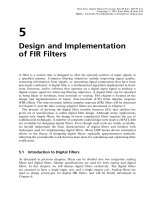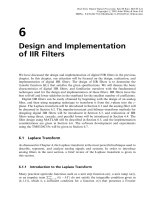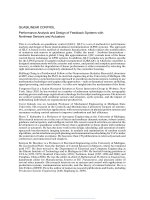integrated security systems design concepts specifications and implementation jan 2007 ebook ling
Bạn đang xem bản rút gọn của tài liệu. Xem và tải ngay bản đầy đủ của tài liệu tại đây (9.14 MB, 471 trang )
TEAM LinG
INTEGRATED SECURITY
SYSTEMS DESIGN
TEAM LinG
TEAM LinG
This page intentionally left blank
INTEGRATED SECURITY
SYSTEMS DESIGN
Concepts, Specifications,
and Implementation
Thomas Norman, CPP, PSP, CSC
AMSTERDAM • BOSTON • HEIDELBERG • LONDON
NEW YORK • OXFORD • PARIS • SAN DIEGO
SAN FRANCISCO • SINGAPORE • SYDNEY • TOKYO
Butterworth-Heinemann is an imprint of Elsevier
TEAM LinG
Acquisitions Editor: Pamela Chester
Acquisitions Editor: Jennifer Soucy
Assistant Editor: Kelly Weaver
Project Manager: Melinda Ritchie
Cover Designer: Eric DeCicco
Butterworth-Heinemann is an imprint of Elsevier
30 Corporate Drive, Suite 400, Burlington, MA 01803, USA
Linacre House, Jordan Hill, Oxford OX2 8DP, UK
Copyright © 2007, Elsevier Inc. All rights reserved.
No part of this publication may be reproduced, stored in a retrieval system,
or transmitted in any form or by any means, electronic, mechanical, photocopying,
recording, or otherwise, without the prior written permission of the publisher.
Permissions may be sought directly from Elsevier’s Science & Technology Rights
Department in Oxford, UK: phone: (+44) 1865 843830, fax: (+44) 1865 853333,
E-mail: You may also complete your request on-line
via the Elsevier homepage (), by selecting “Support & Contact”
then “Copyright and Permission” and then “Obtaining Permissions.”
Recognizing the importance of preserving what has been written, Elsevier prints its
books on acid-free paper whenever possible.
Library of Congress Cataloging-in-Publication Data
Norman, Thomas.
Integrated security systems design : concepts, specifications, and implementation / By
Thomas Norman.
p. cm.
Includes index.
ISBN-13: 978-0-7506-7909-1 (alk. paper)
ISBN-10: 0-7506-7909-3 (alk. paper)
1. Computer networks-Security measures. 2. Information storage and retrieval
systems-Security measures. 3. Computers-Access control. 1. Title.
TK5105.59. N45 2005
005.8–dc22
2006038020
British Library Cataloguing-in-Publication Data
A catalogue record for this book is available from the British Library.
ISBN 13: 978-0-7506-7909-1
ISBN 10: 0-7506-7909-3
For information on all Butterworth-Heinemann publications
visit our Web site at www.books.elsevier.com
Printed in the United States of America
070809101110987654321
TEAM LinG
Dedication
This book is dedicated to the memory of Former Lebanese Prime
Minister Rafik al-Hariri. Mr. Hariri was tragically assassinated
by the enemies of freedom on February 14, 2005 in Beirut,
Lebanon. Rafik Hariri was a visionary leader with a program
to unite Lebanese of all religions together under a common
Lebanese flag, independent of outside influences.
Rafik al-Hariri was a hero to all who knew and loved him.
He saw the future, and the future was peace and prosperity,
not conflict and failure. He was a champion of democracy and
did much to further the cause of the Lebanese people whom he
loved so much.
We miss him every day.
TEAM LinG
TEAM LinG
This page intentionally left blank
Table of Contents
SECTION ONE INTRODUCTION TO INTEGRATED
SECURITY SYSTEMS 1
1 Introduction and Organization of the Book 3
2 Integrated Security System Design Benefits and
Philosophy 13
3 History of Electronic Security 21
SECTION TWO SECURITY SYSTEM DESIGN 35
4 Security System Design Elements 37
5 Electronics Elements (High-Level Discussion) 57
6 Electronics Elements (Detailed Discussion) 65
7 Physical Security Elements 139
8 The Security Design Process 179
9 Preliminary Design Process Steps 191
10 Getting Down to the Actual Design 219
SECTION THREE SPECIAL DESIGN SECTIONS 251
11 Information Technology Systems Infrastructure 253
12 Radio Frequency Systems 307
13 Interfacing to Legacy Systems and Emerging Technologies 329
14 Interfacing to Related Systems 345
vii
TEAM LinG
viii Contents
15 Delaying Technologies and Response Technologies 357
16 Alarm Detection and Emerging Video Technologies 379
17 Design Standards Development 397
18 Finalizing the Installation 407
19 System Implementation 433
TEAM LinG
Preface
The leap from traditional proprietary alarm/access control sys-
tem infrastructures and analog intercom and video infrastruc-
tures to newer Ethernet based system infrastructures is a difficult
one for many security practitioners. Clients, consultants, integra-
tors, technicians and even those in security sales have found the
change to be mysterious, daunting and intimidating.
I was an early advocate of Information Technology (IT)
based infrastructure because it offered something that older
security system infrastructures could not: true enterprise capa-
bility. Ethernet infrastructures permit the distribution of a secu-
rity system across the organization’s facilities all over the world.
That just isn’t possible with older infrastructures.
While I was delighted to see the security manufacturing
industry adopt Ethernet infrastructures, I was distressed to see
that the industry was not seriously addressing the need to pro-
vide for the security of the security system itself on the new
Ethernet infrastructure. When I asked manufacturers why they
were not addressing network security, I received answers like:
“Oh, that is the IT Department’s responsibility,” or “Security
integrators have their hands full just learning how to deal with
Ethernet based systems; we’ll get to network security later.”
So here now was an industry that was responsible for secur-
ing the entire organization’s assets, and the security system itself
ix
TEAM LinG
x Preface
was often not secure. The idea that such a startling vulnera-
bility should itself be so vulnerable was unacceptable to me.
So it was clear that it was important for security professionals
to understand IT theory in order to efficiently design networks
and practical network security.
Soon the security industry will move to systems in which
there are no analog or proprietary wired devices at all; where
all devices connect directly to the Ethernet infrastructure. The
knowledge of how to design efficient network systems and
how to secure those systems is paramount to successful security
systems. This is the future of security technology.
In this book, I also bring the reader insight into some of
the most sophisticated design concepts anywhere in the security
industry. We’ll be discussing design concepts that are able to
make ordinary systems perform extraordinary functions. This
is the one and only book you will need for all security design
concepts.
TEAM LinG
Acknowledgments
a. Most of all, I thank my longsuffering and pure-hearted
wife, Cynthia Kamalo-Norman, who has traveled around
the world to be my partner. I can never enough repay her
kindness, her support, her warmth and affection.
b. I am thankful for the help and support of my confidant and
business associate, Michael Crocker, CPP, CSC, President of
Michael Crocker, CPP & Associates, Inc. and Vice-President
of ASIS International Region 6, as he patiently encouraged
me in the writing of this book, and whose comments and
suggestions have been invaluable.
c. I am grateful for the diligent review of the manuscript by:
• John R. Dew, CPP, Northeast Regional Director of Protec-
tion Partners International (PPI)
• Harvey M. Stevens, PhD, CPP, President of Stevens
Associates, Inc.
• Mr. John Brady, ConocoPhillips
• Mr. Kevin Henson, Asier Technology
• Mr. Paul Williams, Gray Hat Research
• Mr. Nabil el Khazen, Engineered Systems International,
Beirut, Lebanon
• and my protégés Mr. David Skusek and Mr. Adel
Mardelli
xi
TEAM LinG
xii Acknowledgments
d. I am lucky to have had the help of two of the top minds
in Information Technology today to assist in Chapters 10
and 11.
• Paul Williams is one of the leading minds in Informa-
tion Technology Security today. Paul is President of Gray
Hat Research, which is a member of Protection Partners
International.
• Dr. Jack Nisson holds some remarkable patents in WiFi
Antenna Applications. Dr. Nisson has designed anten-
nas that are significantly more immune to out-of-phase
signals, resulting in far better performance. Dr. Nisson
contributed to the section on Wireless Data. Dr. Nisson is
President and Founder of WiFi-Plus, Inc.
e. I am enormously grateful to my publisher and friends, Ms.
Jennifer Soucy, Ms. Pamela Chester, Ms. Kelly Weaver, and
Ms. Melinda Ritchie, for their encouragement and contin-
uous support, and to Butterworth-Heinemann/Elsevier for
their continued support of the Security Community.
f. I am also especially grateful to ASIS International for their
important and foundational support of the Security Industry
and of this small book.
g. And I am also thankful for the support of all of the readers
of my articles and previous book, who constantly encourage
me to keep writing, despite having actually read what I have
written.
h. For each above, I am humbled by their knowledge and
kindness. Their contributions have been invaluable.
TEAM LinG
SECTION ONE
Introduction to
Integrated
Security Systems
TEAM LinG
TEAM LinG
This page intentionally left blank
1
Introduction and
Organization
of the Book
Most integrated security systems installed today are designed to
protect unknown vulnerabilities against unknown threats. They
often use techniques and products that work well to the advan-
tage of the vendor but not always so well to the advantage of
the client, and they are often more expensive than is necessary.
We can change that.
This book is about designing convergence-based integrated
security systems and enterprise integrated security systems
(which are also convergence based). These are security systems
that have three major defining attributes:
• Integrated security systems comprise numerous subsys-
tems together into one complete, highly coordinated, high-
functioning system. Typical subsystems include alarm, access
3
TEAM LinG
4 Introduction to Integrated Security Systems
control, closed-circuit video, two-way voice communication,
parking control, and other related systems. System integra-
tion is the basic concept for all that follows.
• System integration involves both the integration of compo-
nents and the integration of functions. High-level functions
can be obtained by integrating components into a compre-
hensive working system, instead of individual disconnected
subsystems.
• Convergence-based integrated security systems are inte-
grated security systems that utilize TCP/IP Ethernet infras-
tructure as the basic communications media. This is the
result of a convergence of industries (the security tech-
nology industry and the information technology industry).
Most new integrated security systems are convergence-based
systems.
• We will also discuss enterprise integrated security systems
concepts in depth. Enterprise integrated security systems
are those security systems that have been integrated with
other systems, including elevators, private automatic branch
exchanges, human relations programs, and security video
and intercommunications systems, at the corporatewide (the
enterprise) level to perform a wide variety of automated
security-related tasks in a manner consistent with corporate
or agency policies and procedures and that do so uniformly
across the entire enterprise. For example, when an employee
is terminated, the act of pressing OK on the human resources
software screen can cause the employee to also be terminated
from the access control system and information technology
system and even shut down access to his or her telephone
and voice mail. Such integration can prevent a hostile termi-
nated employee from gaining outside access to valuable data
or leaving a forwarding or even antagonistic message on his
or her voice mail. Virtually all but the very earliest enter-
prise integrated security systems are convergence based, and
almost all of the earliest systems utilize some convergence
concepts.
Although you may not need to design enterprise-class inte-
grated security systems, understanding their design concepts
TEAM LinG
Introduction and Organization of the Book 5
will make you a better designer of any convergence-based
integrated security system, so it is worthwhile to be atten-
tive to the enterprise-class concepts when they are discussed
herein.
WHO SHOULD READ THIS BOOK
This book is designed for new and experienced system design
consultants, designers, and project managers who build these
complex systems and for the building owners, security direc-
tors, and facilities directors who operate them. Each will benefit
from the expansive array of issues covered. Many of these sub-
jects have only rarely or perhaps have never been discussed
before in any book to my knowledge. These include such aspects
as how to make your security system virtually disappear on
the information technology system infrastructure, as though it
were not there at all to anyone but the system administrator
(Chapter 17); a complete discussion on how to use security tech-
nology to delay, confound, and take down aggressors in very
high security environments (Chapter 4); and secrets on system
implementation that help ensure a stable, reliable, and high-
functioning system (Chapters 9 and 18). There is some discussion
about pitfalls out of which the potential for lawsuits have arisen
for well-meaning but unsuspecting project participants. My goal
is to help you gain command of every aspect of the process nec-
essary to ensure your success, the success of the project team,
and especially the success of your client.
Designing enterprise integrated security systems seems
daunting to most who have only designed systems for single
buildings or for small campus environments. The challenge
has become ever more important with the advent of terror-
ism and the move toward using electronic security systems to
augment homeland security. The challenge of helping to pro-
tect our nation’s transportation, economic, and cultural infras-
tructure raises the importance of designing what used to be
esoteric systems. Today, these systems are becoming more com-
monplace. However, many of them are being designed using
old skill sets and outdated techniques, resulting in outmoded
and therefore unsuitable products.
TEAM LinG
6 Introduction to Integrated Security Systems
A BRIEF BACKGROUND
In 2003, the security technology industry crested a hill. Behind
us, in the rearview mirror, is yesterday’s technology. Ahead
of us toward the horizon is the technology of tomorrow. It is
different from the past. It is information technology (IT) based.
Many in the security industry are afraid of it. They will resist
the change. They will lose.
In the 1990s, large corporate and government clients
began to understand that they are better served by enterprise-
class security systems. Enterprise systems differ from older
approaches in that they permit the uniform application of secu-
rity policies and procedures across the entire organization. They
permit centralized monitoring of security, business processes,
and adherence to policy. They reduce liability and operating
costs. They permit a user from one facility to freely access any
other if his or her access level permits.
Nearly every manufacturer has embraced the enterprise
security concept, but they are still trying to make it work in the
context of older system architectures. These will all be replaced
by pure IT infrastructures in the near future. By reading this
book, you will be ahead of the game and be able to make design
decisions that will save you and your client tens of thousands
of dollars and many headaches.
These large-scale enterprise-level integration projects raise
the bar, and we must all train well enough to jump over it.
This book presents everything you will need to know to achieve
success on these complex projects.
A FRAMEWORK FOR UNDERSTANDING THE
DESIGN PROCESS
I frequently receive calls from designers who are challenged with
projects beyond their experience, asking how to approach the
task. I tell them the first question is not how, but why? Now,
do not misunderstand me: I do not mean why should I bother?
I mean that the process should begin with a clear and complete
understanding of the following:
• What assets are we trying to protect?
TEAM LinG
Introduction and Organization of the Book 7
• From whom are we protecting them?
• And against what kinds of attack or misuse?
• How can I use integration to improve the operations of my
client and disrupt the operations of criminals and terrorists?
Only after these questions are understood and answered can we
begin to consider what to design and how to approach it. This
book will help you learn how to design large integrated security
systems, beginning with how to approach the project with the
question, why?
GOALS OF THE BOOK
After finishing this book, you will have a new command of the
following:
• Strategic issues
The importance of integrating electronics and physical secu-
rity with a solid foundation of good security management.
How to work with the client’s best interests in mind.
How to know when to integrate systems and when it does
not benefit the client.
The difference between strategic integration and haphazard
integration.
The difference between component integration and integra-
tion of functions.
How to dramatically improve security at a facility using good
integration strategies.
How to lower system and staffing costs and improve
employee productivity using good system integration
practices.
How to create a solid basis for design, including
What is security and what is not.
How to determine the appropriate level of security.
We will examine why you need to know more about IT
systems and cover issues most designers did not know
were important (to their ultimate peril and that of their
clients).
TEAM LinG
8 Introduction to Integrated Security Systems
We will discuss the esoteric side of integration, including how
to design deployable delaying barriers and when and how
to use reactive electronic automated protection systems
that can actively intervene in a security event, stopping it
immediately, from the security command center.
• Technical issues
How to budget systems and plan phased implementation.
We will fully explore the system design elements, including
drawings of each type, and how to write quality specifi-
cations that stand up to challenges and clearly state the
client’s needs. We will examine what can be achieved by
integrating with other building systems and explore the
many ways to interface with them.
We will also examine the foundation of how to design,
including
Drawing hierarchies.
Specification hierarchies.
How to completely integrate drawings and speci-
fication into a single, thorough, and perfectly
understandable set of construction documents.
We will explore in great detail how to design each type of
drawing required, including
Title sheets
Site plans
Floor plans
Elevations
Detail plans
Physical mounting details
Riser diagrams
Single line diagrams
System interface diagrams
System schedules
We will cover every typical aspect of security system
specifications, including how to make them actually
communicate the client’s best interests in a way that the
TEAM LinG
Introduction and Organization of the Book 9
contractor understands what to do, how to do it, and how
to know he or she has succeeded.
We will explore how to select the best technologies to use for
each project with considerations to the client’s best long-
term interests, short-term budget concerns, installation
cost factors, visual aesthetics, long-term maintenance and
reliability considerations, the ability to expand the system
flexibility, and the ability to scale the system size.
We will discuss how to secure the security system from
various kinds of attacks, including insider attacks.
• Tactical issues
We will discuss how to manage client relations so that our
design work is always in his or her best interest and he or
she understands that and has constant confidence in us.
We will examine the differences between what needs to be
in bid documents, construction documents, and as-built
documents.
We will examine each type of technology and explore its ben-
efits and limitations, including alarm and access control
systems, analog and digital security video elements and
systems, security communications systems, system infras-
tructure options, system integration options, and security
command center options.
We will also discuss how to provide bidding support to
clients that gives them a truly empirical standard of
evaluation for which bidder to select.
We will explore the important and delicate matter of how to
review system installation to help ensure the success of
the consultant, the contractor, and the client.
We will also examine legal considerations and how good
system design coupled with quality construction man-
agement and good relationship management can work
together to the success of all project participants, avoiding
problems, confrontations, and lawsuits.
Designing enterprise integrated security systems is exciting,
challenging, and highly rewarding. A well-designed system can
TEAM LinG
10 Introduction to Integrated Security Systems
save a client millions of dollars over its life in improved opera-
tions efficiency, improved safety, and avoided security losses.
The best enterprise integrated security system designers are
highly prized for this reason.
ARRANGEMENT OF THE BOOK
This book is arranged to go from the strategic to the tech-
nical to the tactical. Strategic subjects are covered primarily
in Chapters 1–3, technical subjects are covered primarily in
Chapters 4–10, and tactical subjects are covered primarily in
Chapters 11–19. The strategic section covers the “why” of design,
including some important history that provides insight into how
to stay in the path of industry development and not be side-
tracked as it goes by, the technical section explains how it is
done, and the tactical section provides the cultural knowledge
that leads to project success. If at any time (especially in the
technical section) it gets to be a little too much at once, it is ok
to jump around a bit. If you are not interested in the history of
electronic systems, or any other specific section, feel free to skip
that section; however, each section provides important insight
to the total process. For example, the section on history pro-
vides important insight into how to spot industry trends before
they occur. I have provided advice and consulted with manufac-
turers on important industry developments many years before
they were thought to be important by the manufacturers. Those
who listened and modified their designs accordingly moved out
in front of the industry. Those who did not were left behind.
How did I know where the industry was going? The seeds of
the future are in the past. Understanding how the founders of
the industry dealt with the technical problems they faced pro-
vides us with insight into why things work the way they do
today. Understanding what we want to achieve and how other
industries have dealt with similar problems provides us with
insight into how to manipulate technology to achieve it. The
great body of knowledge is always out there. We only have to
see and not just look. Understanding the industry from strate-
gic, technical, and tactical viewpoints gives us the ability to solve
problems in a way that endures as technology develops and as
TEAM LinG
Introduction and Organization of the Book 11
the organization grows. It is helpful to understand strategic and
tactical aspects first to help understand why the technical details
are so important. Although the challenge is considerable, the
information is easily digestible if you take it in small bites.
The book is also arranged in a way that is useful as a learn-
ing tool and then can be used for years as a reference guide. You
will find that some information is repeated. That is intentional.
All the information herein is organized in a way that guides the
user from the simple to the complex. So you will find a con-
cept presented first, then a discussion of its strategic value, then
tactical applications, and, finally, a discussion on the technical
implementations of the technology.
Welcome to convergence-based integrated security systems
design and thank you for reading.
TEAM LinG
TEAM LinG
This page intentionally left blank









